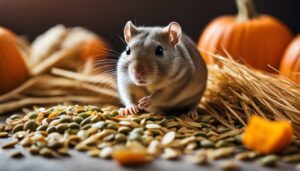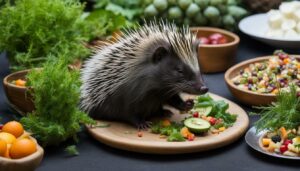If you’re wondering whether guinea pigs can enjoy the sweet taste of figs, the answer is yes! Guinea pigs can indeed eat figs, but it’s important to do so in moderation. Figs offer various health benefits, but their high sugar content means they should be given as an occasional treat rather than a staple food.
Key Takeaways:
- Figs can be safely included in a guinea pig’s diet, but only in moderation due to their high sugar content.
- Feeding figs to guinea pigs can provide benefits such as improved digestive health, bone health, and blood health.
- Remove the stems before serving figs to guinea pigs and ensure they are washed to remove any dirt or pesticides.
- Fresh figs are preferred over dried or canned figs, as they contain more nutrients and are easier for guinea pigs to digest.
- Introduce figs slowly into your guinea pig’s diet and observe their reaction. Serve them in small portions to avoid overfeeding.
Guinea Pig Nutrition: A Balanced Diet for Optimal Health
Proper nutrition is key to keeping your guinea pig healthy and happy. Providing a balanced and nutritious diet is essential for their overall well-being. Guinea pigs require a combination of hay, fresh vegetables, pellets, and occasional treats to meet their nutritional needs. By understanding guinea pig nutrition, you can ensure that your furry friend is getting everything they need to thrive.
1. Hay: Hay is an essential component of a guinea pig’s diet. It provides the necessary fiber for their digestive system and helps maintain healthy teeth. Timothy hay is the most recommended type, but other options like meadow hay and orchard grass can also be included.
2. Vegetables: Fresh vegetables are a great source of vitamins and minerals for guinea pigs. Leafy greens like romaine lettuce, spinach, and kale should make up the majority of their vegetable intake. Other safe options include bell peppers, carrots, cucumbers, and zucchini. It’s crucial to introduce new vegetables gradually to prevent digestive upset.
| Vegetables for Guinea Pigs | Serving Size | Frequency |
|---|---|---|
| Romaine Lettuce | 1 cup | Daily |
| Spinach | 2-3 leaves | 2-3 times per week |
| Kale | 2-3 leaves | 2-3 times per week |
| Bell Peppers | 1 slice | 2-3 times per week |
| Carrots | 1 small piece | 1-2 times per week |
| Cucumbers | 1-2 slices | Daily |
| Zucchini | 1 small piece | 1-2 times per week |
3. Pellets: Pellets specifically formulated for guinea pigs should be given in moderation. They provide additional vitamins and minerals that may be lacking in their hay and vegetable diet. However, it’s important not to overfeed pellets as they can lead to weight gain. A quarter cup of pellets per day is usually sufficient for an adult guinea pig.
4. Treats: While guinea pigs love treats, they should be given sparingly. Fruits like figs can be offered occasionally as a treat, but their high sugar content means they should be fed in small portions. It’s important to remember that treats should not exceed 10% of their overall diet.
Guinea Pig Nutrition: A Balanced Diet for Optimal Health
By providing a well-rounded diet consisting of hay, vegetables, pellets, and occasional treats, you can ensure that your guinea pig receives all the necessary nutrients for optimal health. Proper nutrition plays a vital role in preventing health issues such as obesity, dental problems, and digestive disorders. Remember to introduce new foods gradually and observe your guinea pig for any adverse reactions. With the right diet, your furry friend will be happy, healthy, and full of vitality.
Safe Fruits for Guinea Pigs: Exploring Figs as a Treat
Fruits can be a delightful addition to your guinea pig’s diet, and figs are no exception. However, it is important to ensure that you feed them in moderation. Figs contain a relatively high amount of sugar, which can lead to weight gain and digestive issues if consumed excessively. So, while figs can offer health benefits, it’s crucial to introduce them slowly and serve them in small portions.
Feeding Figs to Guinea Pigs
When it comes to feeding figs to your guinea pig, there are a few things to keep in mind. Firstly, it’s preferable to offer fresh figs over dried or canned ones. Fresh figs provide more nutrients and are generally better for your pet’s health. Before serving, make sure to wash the figs thoroughly to remove any dirt or pesticides. While guinea pigs can eat the skin and seeds of figs, it is essential to remove the stems, as they can be tough and potentially harmful.
It’s always recommended to introduce new foods gradually to your guinea pig’s diet. Start by offering a small piece of fig to see how your furry friend reacts. If there are no adverse effects, you can increase the portion size slightly. Remember, moderation is key, and it’s important to monitor your guinea pig’s overall health and digestion after introducing figs into their diet.
Benefits of Figs for Guinea Pigs
Figs offer several health benefits for guinea pigs. They are rich in fiber, which promotes good digestive health and helps prevent constipation. Additionally, figs contain essential nutrients like calcium, phosphorus, and potassium, which support bone health and overall vitality. The antioxidants present in figs can also contribute to a healthy immune system and protect against cell damage. However, it’s crucial to balance figs with other nutritious foods to provide a well-rounded diet for your guinea pig.
| Benefits of Figs for Guinea Pigs |
|---|
| Promotes good digestive health |
| Supports bone health |
| Provides essential nutrients |
| Boosts the immune system |
In conclusion, figs can be a safe and tasty treat for your guinea pig. However, it’s important to feed them in moderation and monitor their overall health. Remember to introduce figs gradually into their diet, serve fresh figs, and remove the stems. By offering figs as part of a balanced and nutritious diet, you can provide your guinea pig with a variety of flavors and potential health benefits. Consult with your veterinarian for specific dietary recommendations based on your guinea pig’s individual needs.
The Benefits of Figs for Guinea Pigs
Including figs in your guinea pig’s diet can provide them with several health benefits. Figs are a rich source of vitamins and minerals that contribute to their overall well-being. The high fiber content in figs supports good digestive health, helping to prevent constipation and maintain a healthy gut. Additionally, figs contain calcium and phosphorus, which are essential for strong bones and teeth in guinea pigs.
Figs also contain antioxidants, such as vitamin C and E, which help protect your guinea pig’s body from free radicals and promote a healthy immune system. These antioxidants play a crucial role in reducing the risk of certain diseases and promoting their overall health and longevity.
However, it’s important to feed figs to your guinea pig in moderation. While figs can be a nutritious addition to their diet, they are also high in sugar. Excessive sugar consumption can lead to weight gain, dental issues, and digestive problems in guinea pigs. Therefore, it’s essential to limit their fig intake and only offer them small portions as occasional treats.
| Benefits of Figs for Guinea Pigs |
|---|
| Improved digestive health |
| Strong bones and teeth |
| Enhanced immune system |
To serve figs to your guinea pig, it’s best to offer fresh figs rather than dried or canned ones. Fresh figs retain more of their nutritional value and contain higher water content, ensuring your guinea pig stays hydrated. Before serving, remember to wash the figs thoroughly to remove any pesticides or dirt. Additionally, remove the stems to prevent any choking hazards for your furry friend.
In conclusion, figs can be a healthy addition to your guinea pig’s diet. They offer various health benefits, particularly in terms of digestion, bone health, and boosting the immune system. However, it’s crucial to feed figs in moderation due to their high sugar content. Follow the guidelines mentioned, and your guinea pig can enjoy the occasional fig treat while maintaining a balanced and nutritious diet.
Moderation is Key: Managing Sugar Intake
While figs are a tasty treat for guinea pigs, it’s crucial to offer them in moderation. These sweet fruits contain a high amount of natural sugar, which can lead to weight gain and digestive issues if consumed in excess. As responsible guinea pig owners, it’s important to understand the guinea pig food guidelines and their sensitive digestive system.
When feeding figs to your furry friends, remember to serve them in small portions. This ensures that they receive the benefits without overloading on sugar. It’s recommended to start with a small piece and observe how your guinea pig reacts. If they tolerate it well, you can gradually increase the serving size but always keep it moderate.
To help you manage your guinea pig’s sugar intake, here are some guinea pig food guidelines to follow:
| DOs | DON’Ts |
|---|---|
|
|
By following these guinea pig food guidelines, you can ensure that your furry companion enjoys the benefits of figs without compromising their overall health. Remember, a balanced and nutritious diet is key to keeping your guinea pig happy and healthy.
Feeding Figs to Guinea Pigs: Preparation and Serving Tips
To ensure your guinea pig’s safety and enjoyment, it’s important to follow some simple steps when feeding them figs. Figs can be a delicious and nutritious treat for your furry friend, but it’s essential to remember that they should be given in moderation due to their high sugar content.
When preparing figs for your guinea pig, start by washing them thoroughly to remove any dirt or pesticides. It’s also important to remove the stems before serving, as they can be a choking hazard. Fresh figs are preferred over dried or canned ones, as they contain more moisture and nutrients.
Guinea pigs can eat the skin and seeds of figs, so there’s no need to remove them. However, it’s crucial to cut the figs into small, bite-sized pieces to prevent choking. You can offer the figs as a standalone treat or mix them with other fruits and vegetables to provide your guinea pig with a varied diet.
| Key Points: |
|---|
| Wash figs thoroughly |
| Remove stems to prevent choking |
| Cut figs into small, bite-sized pieces |
| Offer as a standalone treat or mix with other fruits and vegetables |
When introducing figs to your guinea pig’s diet, it’s important to start with small portions and observe their reaction. Some guinea pigs may have more sensitive stomachs than others, so it’s crucial to monitor for any digestive issues or changes in behavior. If your guinea pig enjoys figs and tolerates them well, you can gradually increase the serving size, always keeping moderation in mind.
By following these preparation and serving tips, you can safely incorporate figs into your guinea pig’s diet. Remember to prioritize a balanced and varied diet, ensuring that figs are just one part of a nutritious meal. Your guinea pig will appreciate the occasional fig treat and benefit from the vitamins and minerals they provide.
Introducing Figs into Your Guinea Pig’s Diet
When introducing figs to your guinea pig, it’s crucial to do so gradually and monitor their response. Guinea pigs have sensitive digestive systems, and sudden changes in their diet can lead to digestive upset or other health issues. By introducing figs slowly and observing their reaction, you can ensure that they can enjoy this tasty treat without any negative effects.
Start by offering a small piece of fresh fig to your guinea pig. Watch how they eat it and monitor their behavior and stool afterwards. If they show no signs of discomfort or digestive issues, you can gradually increase the portion size over time. However, always remember to maintain moderation as too much sugar can be harmful to your guinea pig’s health.
When serving figs, make sure to wash them thoroughly to remove any dirt, pesticides, or residues. It’s best to serve fresh figs rather than dried or canned ones, as they contain higher amounts of natural nutrients. Remove the stems from the figs before offering them to your guinea pig, as they can be a choking hazard.
As with any addition to your guinea pig’s diet, remember that figs should be given as treats and not as a staple food. A balanced diet for guinea pigs should primarily consist of hay, pellets, and fresh vegetables. Figs can be a healthy and enjoyable addition to their routine, but it’s important to prioritize their overall nutritional needs.
| Do’s | Don’ts |
|---|---|
|
|
By following these guinea pig food guidelines and introducing figs responsibly, you can ensure that your furry friend enjoys the occasional fig treat as part of a healthy and balanced diet. Remember to consult with a veterinarian if you have any concerns about your guinea pig’s diet or health.
Fig Treats: A Healthy Addition to Your Guinea Pig’s Routine
Treating your guinea pig with figs can be a wonderful way to add variety to their diet and make their day a little extra special. Guinea pigs can enjoy the sweet and juicy taste of figs, but it’s important to keep a few guidelines in mind to ensure their health and well-being.
Figs are high in sugar, so it’s essential to offer them in moderation. Too much sugar can lead to weight gain and digestive issues in guinea pigs. To avoid overindulgence, limit the serving size to small pieces of fig. Remember, figs should be considered treats rather than a staple in their diet.
When preparing figs for your furry friend, make sure to wash them thoroughly to remove any dirt or pesticides. You can keep the skins on, as guinea pigs can eat them without any issues. However, it’s important to remove the stems, as they can be tough and difficult to chew.
Table: Do’s and Don’ts for Feeding Figs to Guinea Pigs
| Do’s | Don’ts |
|---|---|
| Wash figs before serving. | Offer figs in large quantities. |
| Feed fresh figs over dried or canned ones. | Forget to remove the stems. |
| Introduce figs slowly into their diet. | Replace their regular food with figs. |
Remember, every guinea pig is unique, and their dietary needs may vary. It’s always a good idea to observe their reaction to figs and adjust the portion size accordingly. If you notice any signs of digestive discomfort, such as bloating or diarrhea, it’s best to consult a veterinarian.
Incorporating fig treats into your guinea pig’s routine can provide them with a delicious and nutritious snack. Just be sure to follow the guinea pig food guidelines, offer figs in moderation, and prioritize a balanced diet overall. With these considerations in mind, your guinea pig can enjoy the delightful flavor of figs while maintaining their optimal health.
Final Thoughts on Feeding Figs to Guinea Pigs
By following a few simple guidelines, you can safely incorporate figs into your guinea pig’s diet and support their overall well-being. Figs can offer several health benefits, but it’s important to remember that moderation is key. Too much sugar can lead to weight gain and digestive issues in guinea pigs, so it’s best to serve figs as occasional treats rather than a daily staple.
When feeding figs to your guinea pig, it’s important to remove the stems and wash the fruit thoroughly. Fresh figs are preferred over dried or canned ones as they retain more nutrients. You can serve figs with the skin and seeds, as guinea pigs can eat them safely.
To introduce figs into your guinea pig’s diet, start by offering a small portion and observe their reaction. If they enjoy the treat and tolerate it well, you can gradually increase the portion size. However, if you notice any digestive issues or changes in their behavior, it’s best to consult a veterinarian.
Remember to consider figs as part of an overall healthy guinea pig diet. Ensure they have a balanced intake of hay, fresh vegetables, and pellets that are specifically formulated for guinea pigs. By providing a varied and nutritious diet, you can help your guinea pig thrive and live a happy, healthy life.
| Benefits of Feeding Figs to Guinea Pigs | Guidelines for Feeding Figs to Guinea Pigs |
|---|---|
| – Improved digestive health | – Serve fresh figs over dried or canned ones |
| – Enhanced bone health | – Remove stems and wash figs before serving |
| – Better blood health | – Start with small portions and observe the reaction |
| – Too much sugar can lead to weight gain and digestive issues | – Adjust portion size based on your guinea pig’s tolerance |
Conclusion
Caring for your guinea pig’s diet is an essential part of being a responsible pet owner. Providing a balanced and nutritious diet is crucial for their overall health and well-being. So, can guinea pigs eat figs? The answer is yes, but it’s important to do so in moderation.
Figs can offer several benefits for guinea pigs, such as improved digestive health, bone health, and blood health. However, it’s important to note that figs have a high sugar content. Too much sugar can lead to weight gain and digestive issues in guinea pigs.
When offering figs to your guinea pig, ensure that you remove the stems and wash the fruit thoroughly. Fresh figs are preferred over dried or canned ones. It’s also recommended to introduce figs gradually into your guinea pig’s diet and serve them in small portions.
Remember, while figs can be a tasty treat for your guinea pig, their primary diet should consist of hay, fresh vegetables, and guinea pig pellets. By providing a well-balanced diet and considering the nutritional needs of your guinea pig, you can help ensure they lead a healthy and happy life.
FAQ
Can guinea pigs eat figs?
Yes, guinea pigs can eat figs. However, they should be fed in moderation due to their high sugar content.
Are figs beneficial for guinea pigs?
Yes, figs can provide benefits such as improved digestive health, bone health, and blood health for guinea pigs.
Can guinea pigs eat the skin and seeds of figs?
Yes, guinea pigs can eat the skin and seeds of figs. However, the stems should be removed before feeding.
Are fresh or dried figs better for guinea pigs?
Fresh figs are preferred over dried or canned figs for guinea pigs.
Should figs be washed before serving to guinea pigs?
Yes, figs should be washed before serving to guinea pigs to remove any dirt or pesticides.
How should figs be introduced into a guinea pig’s diet?
Figs should be introduced slowly into a guinea pig’s diet and served in small portions to observe their reaction.
Can figs be given as treats to guinea pigs?
Yes, figs can be given as occasional treats for guinea pigs. However, it’s important to maintain a balanced diet for their overall health.
What should be considered when feeding figs to guinea pigs?
Moderation is key when feeding figs to guinea pigs due to their high sugar content. Excessive sugar intake can lead to weight gain and digestive issues.
How should figs be prepared and served to guinea pigs?
Figs should be washed and any stems should be removed before serving to guinea pigs. Fresh figs are preferred over dried or canned ones.
How do figs fit into a guinea pig’s overall diet?
Figs can be included as occasional treats in a guinea pig’s diet, but they should not replace the essential nutrients provided by their regular food.




